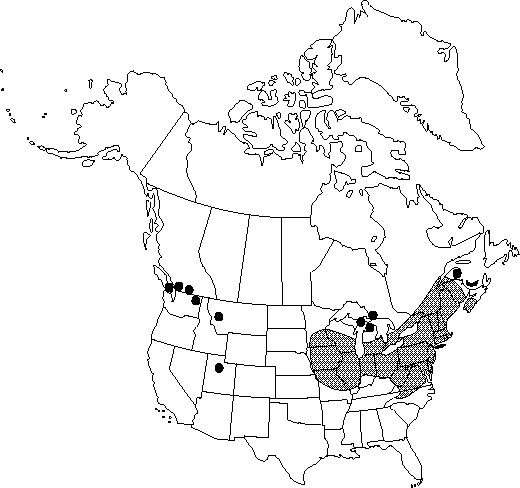Difference between revisions of "Chelidonium majus"
Sp. Pl. 1: 505. 1753.
FNA>Volume Importer |
imported>Volume Importer |
||
| (3 intermediate revisions by 2 users not shown) | |||
| Line 8: | Line 8: | ||
}} | }} | ||
|special_status={{Treatment/ID/Special_status | |special_status={{Treatment/ID/Special_status | ||
| + | |code=W2 | ||
| + | |label= | ||
| + | }}{{Treatment/ID/Special_status | ||
|code=F | |code=F | ||
| − | |label= | + | |label=Illustrated |
| − | |||
| − | |||
| − | |||
}}{{Treatment/ID/Special_status | }}{{Treatment/ID/Special_status | ||
|code=I | |code=I | ||
| Line 33: | Line 33: | ||
|elevation=0-1000 m | |elevation=0-1000 m | ||
|distribution=B.C.;N.B.;N.S.;Ont.;P.E.I.;Que.;Conn.;Del.;Ill.;Ind.;Iowa;Maine;Md.;Mass.;Mich.;Minn.;Mo.;Mont.;N.H.;N.J.;N.Y.;N.C.;Ohio;Pa.;R.I.;Utah;Vt.;Va.;Wash.;W.Va.;Wis.;Eurasia. | |distribution=B.C.;N.B.;N.S.;Ont.;P.E.I.;Que.;Conn.;Del.;Ill.;Ind.;Iowa;Maine;Md.;Mass.;Mich.;Minn.;Mo.;Mont.;N.H.;N.J.;N.Y.;N.C.;Ohio;Pa.;R.I.;Utah;Vt.;Va.;Wash.;W.Va.;Wis.;Eurasia. | ||
| + | |introduced=true | ||
|discussion=<p>The irritating sap of <i>Chelidonium</i> has been used to treat warts. In the vegetative state, this weedy introduction from Eurasia is difficult to distinguish from the native <i>Stylophorum diphyllum</i>.</p> | |discussion=<p>The irritating sap of <i>Chelidonium</i> has been used to treat warts. In the vegetative state, this weedy introduction from Eurasia is difficult to distinguish from the native <i>Stylophorum diphyllum</i>.</p> | ||
|tables= | |tables= | ||
| Line 42: | Line 43: | ||
-->{{#Taxon: | -->{{#Taxon: | ||
name=Chelidonium majus | name=Chelidonium majus | ||
| − | |||
|authority=Linnaeus | |authority=Linnaeus | ||
|rank=species | |rank=species | ||
| Line 57: | Line 57: | ||
|publication title=Sp. Pl. | |publication title=Sp. Pl. | ||
|publication year=1753 | |publication year=1753 | ||
| − | |special status= | + | |special status=W2;Illustrated;Introduced |
| − | |source xml=https:// | + | |source xml=https://bitbucket.org/aafc-mbb/fna-data-curation/src/2e0870ddd59836b60bcf96646a41e87ea5a5943a/coarse_grained_fna_xml/V3/V3_505.xml |
|genus=Chelidonium | |genus=Chelidonium | ||
|species=Chelidonium majus | |species=Chelidonium majus | ||
Latest revision as of 21:49, 5 November 2020
Plants to 10 dm. Stems branching, ribbed. Leaves to 35 cm; petiole 2-10 cm; blade deeply 5-9-lobed; margins irregularly dentate or crenate, rarely laciniate. Inflorescences: peduncle 2-10 cm. Flowers: pedicels 5-35 mm; sepals to 1 cm; petals bright yellow, obovate to oblong, to 2 cm wide; style ca. 1 mm. Capsules linear to narrowly oblong, 2-5 cm, glabrous. Seeds black, reticulate-pitted.
Phenology: Flowering spring–summer.
Habitat: Moist to dry woods, thickets, fields, hedgerows and fences, roadsides, railroads, and waste ground
Elevation: 0-1000 m
Distribution

Introduced; B.C., N.B., N.S., Ont., P.E.I., Que., Conn., Del., Ill., Ind., Iowa, Maine, Md., Mass., Mich., Minn., Mo., Mont., N.H., N.J., N.Y., N.C., Ohio, Pa., R.I., Utah, Vt., Va., Wash., W.Va., Wis., Eurasia.
Discussion
The irritating sap of Chelidonium has been used to treat warts. In the vegetative state, this weedy introduction from Eurasia is difficult to distinguish from the native Stylophorum diphyllum.
Selected References
None.
